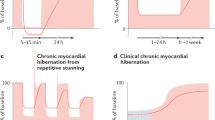Abstract
We report a case of myocardial stunning after acute myocardial infarction. In the hyperacute phase of myocardial infarction, the patient’s coronary arteries showed normal features on coronary angiography during extensive ST-segment elevation observed on a standard 12-lead electrocardiogram and extensive akinesis observed on a left ventriculogram. Thallium-201 emission computed tomography revealed extensive perfusion abnormality. In the chronic phase, the perfusion abnormality was markedly improved. However, the electrocardiogram demonstrated poor R wave progression, and the left ventriculography revealed slight hypokinesis in the anterolateral wall. The acetylcholine provocation test disclosed coronary vasospasm of the left anterior descending coronary artery. About six months thereafter, left ventricular wall motion became completely normal and no poor R wave progression was observed on the electrocardiogram. The findings in this case indicate that myocardial stunning resulted from brief but severe ischemia due to vasospasm which led to cardiogenic shock, and that the recovery of findings for thallium-201 perfusion might be followed by those of electrocardiography and left ventriculography in the stunned myocardium.
Similar content being viewed by others
References
Yasuda T, Molina-murrhy IL, Vandervoot PM, Souther JF. Acute onset of cardiogenic shock associated with normal coronary arteries, diffuse myocardial necrosis, and rapid clinical recovery.J Nucl Med 3: 1558–1565, 1992.
Arvan S, Varat MA. Persistent ST-segment elevation and left ventricular wall abnormalities: A 2-dimensional echocardiographic study.Am J Cardiol 53: 1542–1546, 1984.
Tawarahara K, Kurata C, Okayama K, Watanabe H, Kobayashi A, Yamazaki N. Reversal of perfusion defect on resting thallium-201 emission computed tomography in a patient with stunned myocardium and coronary spasm.Am Heart J 125: 1425–1427, 1993.
Kondo M, Tamura K, Tanio H, Shimono Y. Is ST segment re-elevation associated with reperfusion as indicator of marked myocardial damage after thrombolysis?J Am Coll Cardiol 21: 62–67, 1993.
Braunwald E, Kloner RA. The stunned myocardium: prolonged, post-ischemic ventricular dysfunction.Circulation 62: 1146–1149, 1982.
Kim MS, Akera T. O2 free radical: cause of ischemia-reperfusion injury to cardiac Na+-K+ ATPase.Am J Physiol 252: H252-H257, 1987.
Kloner RA, Ganote CE, Jennings RB. The no reflow phenomenon after temporary coronary occlusion in dog.J Clin Invest 51: 1496–1508, 1971.
Kloner RA, Przyklek K, Patel B. Altered myocardial states. The stunned and hibernating myocardium.Am J Med 86 (suppl): 14–22, 1989.
Moore CA, Cannon J, Watson DD, Kaul S, Beller GA. Thallium-201 kinetics in stunned myocardium charaterized by severe postischemic systolic dysfunction.Circulation 81: 1622–1632, 1990.
Bulkey BH, Silverman K, Weisfeldt ML, Buroww R, Pond M, Becker LC. Pathologic basis of thallium-201 scintigraphic defects in patients with fatal myocardial injury.Circulation 60: 785–792, 1979.
Author information
Authors and Affiliations
Rights and permissions
About this article
Cite this article
Sakata, K., Yoshida, H., Ono, N. et al. A clinical feature of myocardial stunning associated with acute myocardial infarction. Ann Nucl Med 8, 153–157 (1994). https://doi.org/10.1007/BF03165021
Received:
Accepted:
Issue Date:
DOI: https://doi.org/10.1007/BF03165021




